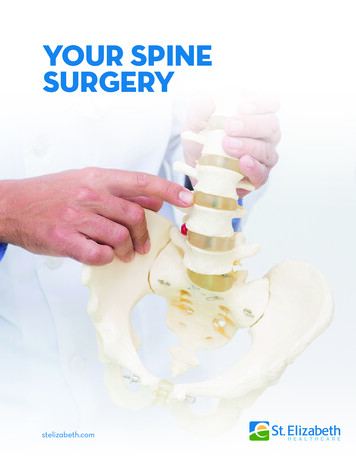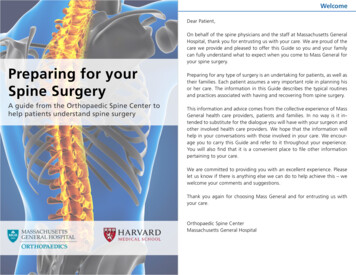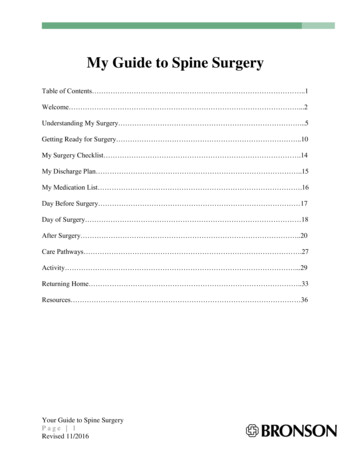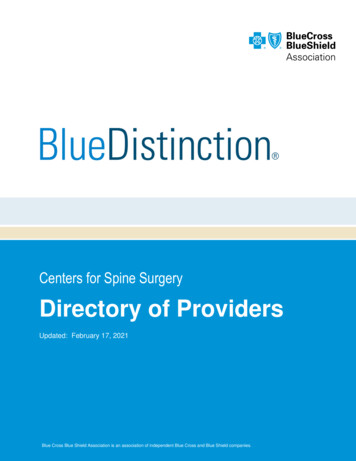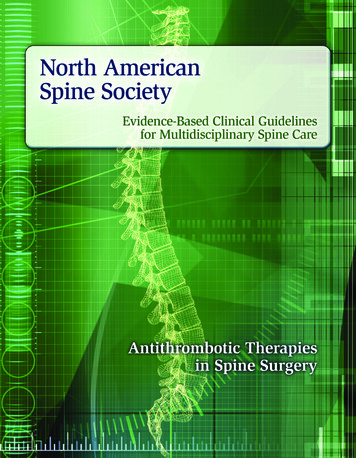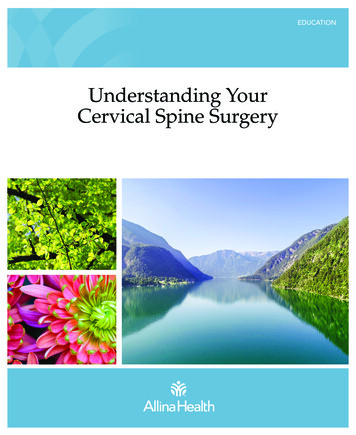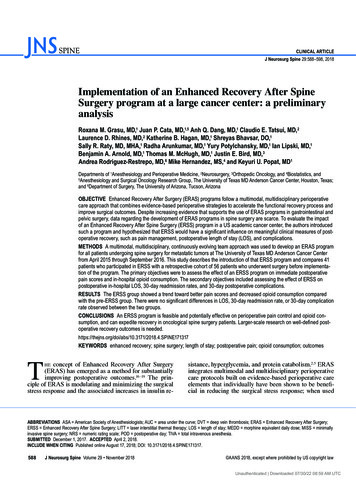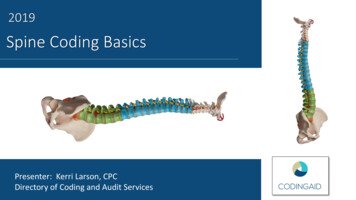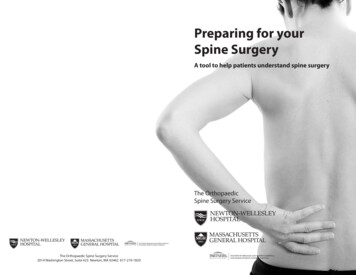
Transcription
Preparing for yourSpine SurgeryA tool to help patients understand spine surgeryThe OrthopaedicSpine Surgery ServiceThe Orthopaedic Spine Surgery Service2014 Washington Street, Suite 423 Newton, MA 02462 617-219-1820
WelcomeDear Patient,On behalf of the spine physicians and the staff at Newton-Wellesley Hospital,thank you for entrusting us with your care. We are proud of the care weprovide and pleased to offer this Guide so you and your family can fullyunderstand what to expect when you come to Newton-Wellesley Hospitalfor your spine surgery.Preparing for any type of surgery is an undertaking for patients, as well astheir families. Each patient, as an individual, assumes a very important role inplanning his or her care. The material in this Guide describes the typical routinesand practices associated with having and recovering from spine surgery.This information and advice comes from the collective experience ofNewton-Wellesley Hospital health care providers, patients and families. Inno way is it intended to substitute for the dialogue you will have with yoursurgeon and other involved health care providers. We hope that the materialwill help in your conversations with those involved in your care. We encourageyou to carry this Guide and refer to it throughout your experience. You willalso find that it is a convenient place to file other information pertaining toyour care.We are committed to providing you with an excellent experience. Please letus know if there is anything else we can do to help achieve this – we welcomeyour comments and suggestions.Thank you again for choosing Newton-Wellesley Hospital and for entrustingus with your care.Newton Wellesley HospitalOrthopaedic Spine Surgery Service
Table of ContentsSection 1: Spine Anatomy and Procedure Overview.2Section 2: Staff You Will Meet.6Section 3: Preparing for Surgery.8Section 4: Anesthesia. 14Section 5: Surgery. 14Section 6: Your Hospital Stay. 17Section 7: Leaving the Hospital. 23Section 8: Frequently Asked Questions after Back Surgery. 281
Section 1: Spine Anatomy and Procedure OverviewAs a patient considering spine surgery, you probably have many questions. Thisinformation will help prepare you for what to expect during your hospitalization.The spine is made up of a series of vertebra. There are seven cervical (neck),12 thoracic (chest) and five lumbar vertebrae. The vertebra is composed of asolid section called the body thatsits anteriorly and a ring of boneFigure 1: Spine Vertebraeposteriorly (shown in Figure 1).This ring of bone creates a canalthrough which the spinal columnand nerve roots run.The bony arch consists of the pedicle,paired transverse process, facetjoints, lamina and spinous process(shown in Figure 2).Between each vertebra is a discthat serves as a shock absorber andprovides height between two vertebrae. The disc has circular bands ofcartilage called the annulus, whichencases a gelatinous center calledthe nucleus (shown in Figure 3).Figure 2: Superior Articular ProcessThe disks between the vertebraeallow the back to flex or bend. Disksalso act as shock absorbers. Disksin the lumbar spine (low back) arecomposed of a thick outer ring ofcartilage (annulus) and an innergel-like substance (nucleus). In thecervical spine (neck), the disks aresimilar but smaller in size.With aging and the wear and tearwe put on our backs, degenerative changes in the spine can occur. The disksbetween the vertebrae (bones) may degenerate and lose some of their watercontent. The annulus may weaken, allowing the disc to protrude or becomeherniated (shown in Figure 4).2The facet joints may develop bonyovergrowth due to arthritis. Thesechanges can also lead to narrowing,or stenosis, of the spinal canal.Spinal stenosis can cause thenerves to be pinched as they passthrough the canal and foramina(shown in Figure 5). The nervesbecome inflamed, causing painin the buttocks and/or legs. Thesechanges can occur anywhere alongthe spine. We frequently see patho logies develop in the neck (cervical)or lower back (lumbar) spine.Figure 3: Superior Articular ProcessFigure 4: Osteoarthritic Facet JointsNeckAs with pain in the lower back,neck pain is also common. Whenpressure is placed on a nerve in theneck, it causes pain in the musclesbetween your neck and shoulder(trapezius muscles).The pain mayshoot down the arm. The pain mayalso cause headaches in the back ofthe head. Other symptoms include: Weakness in one arm T ingling (a “pins-and-needles”sensation) or numbness inone arm B urning pain in the shoulders,neck or armFigure 5: LaminaOver time, arthritis of the neck(cervical spondylosis) may resultfrom bony spurs and problemswith ligaments and disks. Thespinal canal may narrow (stenosis)and compress the spinal cord andnerves to the arms.3
Lower BackWhat You Can ExpectLow back pain affects four out of five people. The most common symptom ofa herniated disk is sciatica – a sharp, often shooting, pain that extends fromthe buttocks down the back of one leg. It is caused by pressure on the spinalnerve. Other symptoms include:Surgical time for spinal procedurescan vary depending on the numberof vertebral levels addressed andthe complexity of the case. Hospitalstays vary on an individual basis.Patients are usually admitted on themorning of surgery. Routine careafter spine surgery involves woundcare, pain management, physicaltherapy and occupational therapy. These are described in greaterdetail later in this Guide. Weakness in one leg Tingling (a “pins-and-needles” sensation) or numbness in one leg or buttock Loss of bladder or bowel control(Significant weakness in both legs could indicate a serious problem and youshould seek immediate attention).Degenerative changes may also lead to abnormal motion between the vertebrae(instability). Degenerative changes in the lower back can lead to forward slippageof one vertebra on another, a painful condition called spondylolisthesis.When conservative measures fail to relieve pain, your physician mayrecommend surgery.About the ProceduresFigure 6: LaminectomyA Laminectomy or decompressionof the spine is done to eliminatepressure on the nerves from boneor soft tissue (often discs). A portionof the lamina is removed, this isoften done with a spinal fusion(shown in Figure 5 and 6).Spinal fusion surgery permanentlyfuses together bone segments(shown in Figure 7) and eliminatesmotion between vertebral segmentsusing bone graft. Bone graft maybe laid down between the vertebraeor along the posterior portion ofthe vertebrae. In addition, rods,screws and cages are used to immobilize the spine in the area while the bonyfusion is healing. Spinal fusion will take away some spinal flexibility. However,most spinal fusions involve only small segments of the spine and therefore, donot limit very much motion.Figure 7: Spinal FusionRecovering from spine surgerydepends on your general healthbefore the procedure and your levelof activity. The goal of recoveryis to comfortably return to the activities of daily living that are important toyou. While most spine surgery is successful in relieving pain and/or improvingmovement, recovery does take time. Nerve root discomfort may take time toheal and varies from patient to patient.The soft tissues at the surgical site will take three to four months to completelyheal, but the majority of the healing happens in the first six weeks. Musclestrength and reconditioning takes time, depending on how deconditionedyou are preoperatively. Bone healing and fusion consolidation generallyhappen between six and twelve months after surgery. Nerves may continueto heal for one to two years after surgery. Depending upon the problem, mostpatients experience back pain improvement compared to preoperative painthree to six months after surgery.Kyphoplasty is a minimally invasive treatment for vertebral body compressionfractures caused by osteoporosis and certain cancers. This procedure is usuallyperformed under local anesthesia.45
Section 2: Staff You Will MeetCare Coordination Team Case Manager. This is a nurse who may assist with your discharge planningYour Health Care TeamIt takes many people to make a hospital run smoothly. Your health care teamwill work together to make your Hospital stay a positive, comfortable andsuccessful experience. Please feel free to ask questions and share concernswith any member of your health care team. The following is a list of some staffmembers who will provide your Hospital care:Attending Physician. This is your surgeon who will be primarily responsiblefor your care during your Hospital stay. He will work in conjunction withfellows, residents, physician assistants (PAs) and nurse practitioners (NPs)to provide comprehensive care. Fellows. Doctors who have completed residency training in orthopaedicsurgery and are specializing in spine surgery. Residents. Doctors in their second through fifth year of specializedtraining in orthopaedic surgery. Physician’s Assistant. A clinician with specialized training who may assistyour surgeon in the Operating Room (OR), during your Hospital stay andat your follow-up appointment. Nurse Practitioner. A nurse with advanced training who may assist yoursurgeon in the Operating Room (OR), during your Hospital stay and atyour follow-up appointment.Anesthesiologist. A medical doctor with advanced training in anesthesiology. Nurse Anesthetist (CRNA). A nurse with advanced training who administersanesthetics under the supervision of an anesthesiologist.Hospitalist. A medical doctor who may see you at the request of your surgeon.Nursing Staff. A registered nurse (RN) will care for you throughout yourHospital stay. Your nurse will make sure you receive the appropriate medications,medical treatments and tests ordered by your physicians. Your nurse will alsoprovide information and education to prepare you for discharge. A nurse isalways available to answer questions or to discuss concerns you or your familymay have. The name of the nurse caring for you on each shift will be availableat the nurses’ station or listed on a board in your room. Patient Care Assistant (PCA). The patient care assistant will assist yourif you need services and/or equipment upon discharge. The case manageris familiar with resources in your community and may be able to helparrange homecare, or if necessary, an appropriate extended-care facility. Heor she can also help with any questions or problems about what servicesand/or equipment your medical insurance covers, as well as financial issuesthat may impact your recovery and/or access to services/equipment. Social Worker. A social worker is always available to discuss any concernsthat you or your family may have related to your disease and the associatedstress it may have on you and your significant others, including whatconcerns you may have about planning for discharge. He or she may alsoassist with arranging homecare, placement in an extended-care facility,and/or facilitating equipment needed for home.Rehabilitation Staff. These staff members have an important role in helpingyou recover from your spine surgery. Physical Therapist (PT). A PT may work with you during your hospitalstay to get you moving around safely after your surgery. The PT will teachyou how to safely get in and out of bed, walk with or without a deviceand walk up/down stairs (if needed). The PT will educate you regardingyour surgeon’s expectations for you upon leaving the hospital. Occupational Therapist (OT). The OT will address training you in how toperform activities of daily living including bathing, dressing, grooming, andtoileting so that you are as safe and independent as possible, either withthe use of adaptive equipment or with compensatory strategies focusingon body mechanics. The OT will address training with functional mobilityand transfers to assess for any necessary equipment or DME you mightneed at your toilet or tub/shower stall area prior to your discharge home. Physical Therapy Assistant (PTA). A PTA may assist your physical therapistin exercises and mobility training. The PTA carries out the goals set bythe PT. While we try to maintain consistency in care having your sametherapist, it may be necessary to have a different therapist or PTA followyou after your initial evaluation.Other Hospital Staff. Housekeepers, dietary workers, radiology technicians,chaplains, pharmacists, transporters and other staff members are all part ofyour health care team.nurse in providing your daily care. He or she may help with bathing,taking vital signs or transporting you to and from tests.67
Section 3: Preparing For SurgeryThe nurse will: Confirm your surgical procedure. C onduct a nursing assessment, which includes past medical conditions,Once you have scheduled your surgery, preparing yourself physically andmentally are important for a healthy recovery. Here are a few steps to helpyou get ready for your surgery.Surgery Pre-Registration and Pre-Surgical AssessmentBefore you come to the Hospital for surgery, you must complete yourpre-registration. Your surgeon’s administrative assistant will help youcoordinate your pre-surgical appointments at Newton-Wellesley Hospital,as well as any required preoperative clearance or testing.Insurance Co-PaymentsDepending on the type of insurance you have, you may be responsible fora co-pay for your surgical procedure. The amount will vary depending onyour insurance provider. A Newton-Wellesley Hospital staff member from theAdmitting Department will be contacting you to determine the best way totake care of your co-payment.Pre-Admission VisitOnce your surgery has been scheduled, your surgeon’s office will arrange apre-admission screening appointment. This visit will be scheduled as many asfour weeks before your surgery. This is a separate appointment from your visitwith your surgeon or PCP. During your appointment, you will meet staff fromthe Anesthesia department. The purpose of this visit is to make sure you aremedically optimized for your surgery under general anesthesia. The averagepre-admission visit is about two to three hours long. Please eat before thisvisit and take your regular medications.On the day of your pre-admission visit, be sure to bring the following information: Questions you have about your surgery. A list of your allergies. A list of medications and dosages you take on a regular basis, includingvitamins, herbs and other over-the-counter medications. Results of any recent tests at other hospitals. Names, addresses, phone numbers of all your doctors, including specialists. Any previous problems or reactions to anesthesia.8previous hospitalizations and a complete list of medications includingprescriptions, over-the-counter and any dietary supplements. Confirm any allergies you have to drugs, food or latex. Review arrival time for the day of surgery. Recommend a special soap to wash the area the day before surgery.You will also have any testing your physician has ordered. This may include labtests, an EKG and a chest x-ray.AnesthesiaA member of the Anesthesia Department is available to speak with youbefore surgery and let you know if any medications need to be stoppedbefore surgery (see medication list in this Section).Informed ConsentBefore surgery you will be asked to sign consent forms. You have the rightto understand your health problem and treatment options in words you canunderstand. Your doctor should also tell you about the risks and benefits ofeach treatment. Please feel free to ask questions.Preparing Yourself PhysicallyHere are some tips that will help you focus on a smooth recovery. Stay as active as possible. I t is important to share with staff any pain medication you are currentlytaking. This will better allow us to plan for your comfort after surgery. C ontinue your normal activity and exercise programs. Stop smoking. If you smoke, try to stop or cut back on the number ofcigarettes you smoke every day. Smoking can cause complications withthe anesthesia you receive for your surgery. Smoking also inhibits woundhealing and bone healing. There is a 50% chance your fusion will not heal ifyou continue to smoke. Smoking decreases blood flow to healing tissues by25% and accelerates arthritic changes. People who smoke have more backand neck pain than non-smokers. Stopping even for a short time can behelpful. For help, you may contact the Quit Smoking Programs at:9
Brigham and Women’s Hospital (617-732-8983)Planning for Your Return HomeMassachusetts General Hospital (617-726-7443)It is important to begin planning for your return home before your surgicalprocedure. Arrange for transportation home from the Hospital. After surgery,your surgeon and other members of the health care team will assist inplanning for your discharge. Have family and friends available to assist youwith activities such as wound/dressing care, household tasks, driving, andpicking up prescriptions from the pharmacy.For further information, contact1-800-TRY-TO-STOP or visit www.trytostop.org1-800-QUIT-NOW or visit cdc.gov/tobacco W atch your weight. Your doctor may ask you to lose weight before surgery.You may want to contact a dietitian for help losing weight or maintaininga lower weight after surgery. Resources are available by contacting ourNutrition Department at 617-243-6617. D iscuss the need for a routine dental exam prior to surgery with your surgeon. I f you have a fever, flu symptoms or other medical issues, please contactyour surgeon’s office.Physical Therapy and/or Occupational Therapy goals to achieve prior toreturning home include:1. G etting in and out of bed while the bed is in the flattened position withoutthe use of a rail, using the logroll technique.2. B eing able to come to a standing position with or without the help of anassistive device such as a walker or cane.3. B eing able to walk at least 150 feet with or without the help of an assistivedevice such as a walker or cane.Preparing Yourself MentallyHaving surgery can be stressful. It is important to be an informed patient.Learn as much as you can about the surgery and discuss realistic expectationswith your surgeon and staff. Share this information with family members andfriends who will be involved in helping you with recovery. Don’t hesitate toask for help from others during your recovery. It is important to plan for helpin place during your recovery period.4. Successful full body bathing and dressing with or without the use ofadaptive equipment and incorporation of good body mechanics.5. Review of any precautions you may have prior to going home.6. Being able to negotiate the stairs with or without a rail (if used at home.)You may or may not require use of a cane to perform.7. Understanding that your only initial exercise at home may be to walk.Case ManagementIf needed, you will meet with a case manager during your hospital stay. At thistime, he or she will discuss options for services after discharge. Many patientsare able to return directly home after hospitalization. Some may qualify forservices from a home-care agency. However, some patients may need additional time in an extended-care facility to achieve their goals. Your eligibilityfor care in an extended-care facility and/or home-care services is determinedby a number of factors, including physical need and insurance coverage. Yourinsurance company must authorize any services. Your health care team willwork with you to make the decision that is right for you.If you have any questions or concerns regarding your post-rehabilitationoptions, please call the Department of Health Care Quality at 617-243-6695.8. Successful entry and exit from a tub or shower stall.9. Ability to sit and stand from a standard toilet or commode.The Rehabilitation staff will help you plan for any equipment you may needat home, such as: Bedside commode Raised toilet seat Shower chair/bench L ong handledadaptive equipment Hand held shower hose Safety bars/hand rails Knee immobilizer Ankle foot orthosis (AFO) N eck or low back brace(as recommended by your surgeon) Cane Rolling walkerThis equipment is not always covered by your insurance.1011
Medication GuidelinesHome Safety ChecklistSeven to 10 days before surgery, you should stop taking aspirin and otheranti-inflammatory agents (Ibuprofen, Motrin, Advil, Aleve) to prevent excessivebleeding peri-operatively. Other drugs that should also be stopped seven to10 days before surgery include Plavix, Coumadin or other similar anticoagulationdrugs. A complete list of medications and substances that should be stoppedbefore surgery is provided in this Section. Anesthesia will review this with you.The Occupational Therapy Department has compiled the checklist below tohelp you prepare your home for your recovery. We encourage you to reviewthis list with family and friends and make any needed changes BEFORE yoursurgery. These recommendations can help you safely manage at home duringyour recovery period. Do not take vitamins, fish oil, or other herbal supplements for one weekbefore surgery.your home, as they can easily become caught under canes/walkers. Make sure carpet edges are tacked down to reduce potential falls. If aspirin is prescribed, please check with your primary care doctor orcardio logist before stopping this. You may take acetaminophen (Tylenol). You may not be aware of the many medicines that contain aspirin oracetaminophen. Most medicines that help to relieve the symptoms ofcold or sinus congestion contain aspirin or acetaminophen. Look at theingredients on the label to ensure your safety. Notify your surgeon if you are on Warfarin (Coumadin), Plavix, Xarelto, oranother anticoagulation medication.The following is a partial list of other over-the-counter products that containaspirin or aspirin-like medicine. These may affect bleeding during and aftersurgery. If you are taking any of these medicines, check with the AnesthesiaDepartment about discontinuing trengthBufferinA.S.A. and edicationsBayer Aspirin Remove all loose rugs and electrical cords from areas where you walk inBufferinCephalgesicChildren’s Way Cold dolMotrinNardilNaprosynNorgesic ProductsPepto VanquishVoltarenZactrin Be sure all walking areas are free of clutter. You will need a stable chair with a firm back and seat cushion that allowsyour knees to be lower than your hips when sitting during the day. Seatheight can be built up with a firm pillow or folded linens. A chair with armsis recommended. Also make sure that your bed height is 18 inches or more, in order to keepyour hips above your knees when you sit on the edge. Inexpensive bedrisers can be placed under bed legs. Place needed items in the bathroom, bedroom, kitchen and living areaswithin easy reach (not too high, and not too low). Keep a cordless phone or cell phone with you during the day. Place rubber mats or non-slip decals in the tub/shower. If you have equipment, such as a commode or tub seat, take it out beforeyour surgery to make sure it is in good working order. Consider having grab bars installed in the tub/shower wall and near thetoilet to optimize safety when toileting or bathing. If planning on usingsuction cup grab bars, be aware that there are safety concerns andprecautions to consider. Properly installed grab bars are always preferable. A hand-held showerhead can be helpful when sitting on a tub seat to shower. Put nightlights in your bathroom and in the hallway leading from yourbedroom to bathroom. Ensure that stair handrails are securely fastened and extend the full lengthof the stairs. Be sure that outdoor walkways, steps and porches are free of rocks, looseboards and other tripping hazards.Feel free to contact the Occupational Therapy Department at 617-243-6172 ifyou have questions about these recommendations.13
Section 4: AnesthesiaWhat To Take To The Hospital Asthma inhalers and any eye dropsAnesthesiologists and nurse anesthetists are responsible for your safety andcomfort during surgery. A member of the Anesthesia Department will bewith you at all times in the Operating Room. Nearly all spine surgeries areperformed under general anesthesia.General anesthesia involves medications that keep you completely asleepduring surgery. These medications are given intravenously(IV) and by inhalation. Some of the most common side effects of generalanesthesia include nausea, vomiting and sore throat. You will be givenmedication to prevent nausea. The anesthesiologist will describe these risksto you when you sign a consent form for anesthesia. This consent is separatefrom your consent for surgery. A ny non-formulary medications that are not stocked in the hospital pharmacy(please check with Anesthesia Department or your surgeon’s office) P ersonal toiletries S hort robe and loose pajamas P ersonal toiletries F lat comfortable shoes/sneakers and socks G lasses for reading (leave contact lenses at home) D entures and case C ell phone or prepaid phone card for long distance calls S mall amount of cash (no more than 20 in case you want to buy newspapers). C ompleted Health Care Proxy formSection 5: SurgeryDo Not BringO P ocketbook, wallet or other valuables including watches, earrings andDay Before Surgeryother jewelryOn the day before your surgery, make sure to follow these specific instructions: S hower and wash your body thoroughly with soap recommended byArriving at the Hospital F ollow the instructions you received at your pre-admission visit about allHospital admission usually occurs on the day of your surgery. You will beasked to arrive at the Hospital one and a half hours before surgery. Afterchecking in at the Surgical Centerpre-test staff.your medications. D o not eat solids after midnight including food of any kind, milk or coffeelightener, orange juice, alcohol, gum, candy and mints. C lear liquids are allowed up to four hours before surgery including water,black coffee, clear tea, apple juice (no cider) and cranberry juice. A bsolutely nothing by mouth within four hours of surgery.Registration, you will be taken to the preoperative holding area. Yourbelongings will be stored and delivered to your room later in the day.A nurse in the pre-operative area will coordinate your preparation forsurgery, which includes: M eeting your perioperative team who will assist your surgeon.Your team may include:NursesOrthopaedic residentAnesthesiologistPhysician Assistant (PA)Nurse Anesthetist (CRNA)Nurse Practitioner (NP)Orthopaedic spine fellow C hecking your vital signs (temperature, blood pressure, pulse, respirationsand pain score).1415
P lacing an intravenous (IV) tube in your arm so that you can receive fluids,medications and blood transfusion if necessary.Your family is welcome to stay with you until it is time to go to the OperatingRoom (OR). When you are taken to the OR, your family will be directed to thefamily waiting area where they can wait during your surgery.SurgeryIn the OR, the surgical team will work to ensure your procedure goes smoothly.They will be continuously watching your heart rate, blood pressure andbreathing. A catheter (small tube) may be placed in your bladder to keeptrack of fluids during surgery. Your surgeon will speak with your family whensurgery is completed.After Surgery – Post Anesthesia Care UnitAfter surgery, you will wake up in your bed in the recovery room known as thePost Anesthesia Care Unit (PACU). You may not remember much of this partof your stay. Here are some of the routine activities that will be happening asyou wake up from your surgery. Your vital signs will be taken frequently. Y ou will have oxygen and cardiac monitoring while you wake up fromthe anesthesia. Y ou will be wearing TEDS stocking and compression boots to promotecirculation. Compression boots are wraps that are placed on your legs. Thewraps are attached to a machine that automatically inflates and deflates. Y ou may have a small drain from your incision that drains extra fluid fromunder the skin. Y ou may have a catheter (tube) from your bladder. T he nurse will check on IV fluids and antibiotics you receive. Y ou will be asked to cough and breathe deeply every hour while you are awake. Y our nurse will check to make sure you are as comfortable as possible. Thenurse will frequently ask you to rate your pain using a pain scale from zeroto 10, with zero being no pain and 10 being severe pain. Your pain will bemanaged in one of several ways:º Patient controlled analgesia (PCA). A pump that releases pain medicationin small doses through your IV. Your physician will order the amount andtype of medication for you.º Narcotic pain medication. Medication taken by injection or by mouth.16Section 6: Your Hospital StayDuring your recovery, the focus of your care will be on managing your pain,caring for your incision and getting you moving again. It is difficult to describea typical day in the Hospital because each pat
2 3 Section 1: Spine Anatomy and Procedure Overview As a patient considering spine surgery, you probably have many questions. This information will help prepare you for what to expect during your hospitalization.
